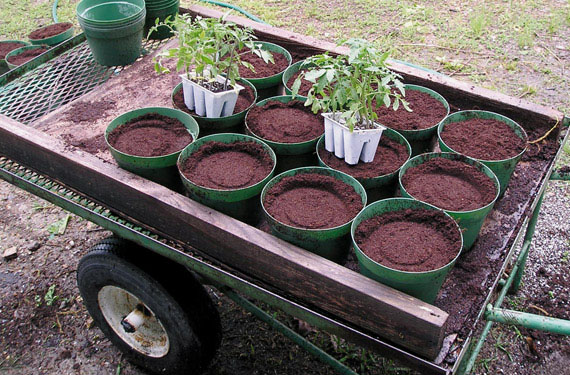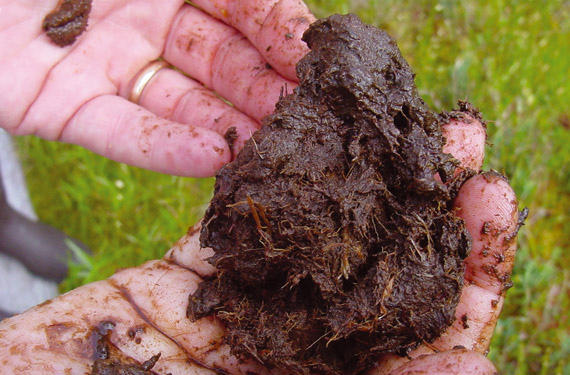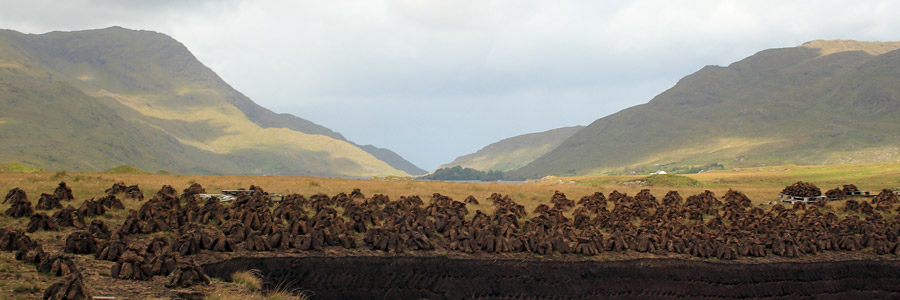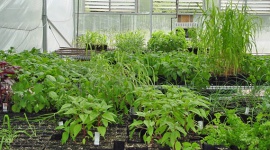TERRA, about peat and feed - part 2
In this article we’ll be looking into the structure of potting mixes and the differing products obtained from the different methods of cutting peat. On top of all this useful information we’ve worked out some valuable tips for you to reduce disease and increase yield and we’ve drawn up that promised list of FAQs and growing tips.

But we’ll start off by discussing how best to measure the nutrients present in your growing medium. This will also come in handy towards the end of your grow, when you decide whether or not to reuse your potting mix. More about that elsewhere in this article where we talk about rejuvenating the potting mix.
Reliable measuring method
The most reliable way of measuring the nutrients present in the potting mix is to use the 1:1.5 extraction method, which can be used to determine the EC and pH in the root environment. The EC and the pH of the drainage water will normally vary because the potting mix is capable of holding back a number of elements or even refusing them. It is best to carry out a 1:1.5 analysis after three to five weeks. The easiest way to make this analysis is to follow the plan given below step by step:
- Take a potting mix sample. This can be done with a ground drill or a spoon. Take the potting mix from a large number of different places to ensure that the sample is representative.
- Put the sample in a bowl and determine if it is moist enough. This is done by squeezing some potting mix in your hand; if moisture comes out it is OK. To increase the sample’s moisture content add distilled water. Mix the potting mix well after adding water.
- Take a 250 ml measuring jug and fill it with 150 ml of distilled water. Add potting mix to bring the volume up to 250 ml, mix it well and leave it for at least 2 hours.
- Mix it well once again and measure the pH.
- Filter the mixture that you now have and measure the EC. Target values for the EC are between 1.1 and 1.3 and for the pH between 5.8 and 6.2.
Structure of potting mixes
The structure of potting mixes determines how much water and air are available to the roots growing in the potting mix. Air is important for the roots’ oxygen supply and for the micro-organisms in the root environment. Roots need oxygen to grow, to maintain the root system and for the intake of water and nutrients. To obtain good final results for fast growing plants, it is even more important to ensure there is a good supply of air in the root environment. A shortage of air in the early stages of cultivation will result in a poorly developed root system, which will hamper growth, resulting in a smaller yield. In order to ensure that the root environment has sufficient air it is necessary for oxygen to be taken from the air in the growing room, which happens, by diffusion.
The structure of the potting mixes will mainly depend on the quality of the raw materials in it. In order to get good potting mix it is essential to start with virgin peat that has stable structural characteristics.
One of the main ingredients in potting mix is peat. This is an ancient natural material that is formed from old vegetation. Peat originates from regions where climatic circumstances caused new plant material to form faster than the dead vegetation could rot. Slowly but surely this process has built up a layer of organic material that could become several metres deep. Two different types of peat can be differentiated: high peat and low peat.
1. High peat; is formed under the influence of rainwater in low nutrient regions and its principal ingredient is sphagnum moss. This is a small plant that dies off from below while continuing to grow above on its own remains. The remains of other plants can also be found, cotton grass for example. The profile of the high peat in the flat peat region in Northwest Germany contains different layers that have been formed in different periods.
2. Low peat; is formed in regions where groundwater levels are high and there are plenty of nutrients. Low peat typically contains a high proportion of rotten material and can have high levels of silt; sand and harmful salts which make it an unsuitable basis for good potting mix.

Vertically cut or shaved peat?
2 different methods can be used to exploit peat deposits:
- The cheapest but least efficient method consists of ‘shaving off’ the top layer of peat. The disadvantage of this technique is that the structure becomes less coarse which has an undesirable effect on the air/water relationship.
- The second method consists of cutting the peat vertically. This is the most well-known method from times gone by. The peat blocks that were previously used for fuel for cooking and heating homes were cut in this way. This is an expensive way of extracting peat.
When peat is cut into blocks it has to be turned by hand to dry out. The coarser the peat is, the better the balance between the water and air it contains. This means the plant’s roots will develop better in the growing medium, that the plants will be healthier and that the potting mix is less likely to become compressed.
Sphagnum moss
Sphagnum moss is particularly suitable for use as a growing substrate because it is natural, light, clean and easy to work with. It has a low nutritional content, a pH that ranges from 3.5 to 4.5 and it has good water retention properties (up to 20 times its own weight).
Prevent stress
In this section we will give you some tips to prevent plant stress in your growing room. Besides publishing CANNAtalk, CANNA also produces some useful things to help you with your growing hobby.
In a root system that is functioning properly some roots will die off and new ones will form. The dead roots form an ideal food source for pathogens. Once pathogenic fungi have multiplied in the dead root material they form a threat to the healthy roots, which can be easily attacked causing a sharp decline in the performance of the roots.
As a result the entire plant will come under stress and growth will be stunted. To prevent this happening you need to make sure that the decaying old roots are broken down quickly into useful components. A product such as CANNAZYM can best be used in such a situation. The enzymes in CANNAZYM ensure that dead root material is quickly converted into minerals and sugars. This is important because these elements form an important nutritional source for the plants and the potting mix environment.
Also, rotting produces poisonous materials, which will be counteracted, and the chance of infection arising caused by pathogenic fungi will be reduced considerably. As well as this, a number of easily absorbable vitamins have been added to CANNAZYM, which will stimulate the plants to produce new roots. This is a good reason for adding a little CANNAZYM continually to your feeding solution from the second week of cultivation, dilute it in the ratio 1:400.
To get your grow off to a flying start why not give your plants some tonic? CANNA RHIZOTONIC is a powerful, vegetable based root stimulator. It causes extra root growth and in this way helps the plants to establish themselves more quickly.
For this reason RHIZOTONIC is an ideal product for cuttings and plants that have to be potted or for plants that have developed poorly after being in a state of shock. As well as this RHIZOTONIC contains a wide variety of trace elements that are advantageous for the plants. The tonic is easy to apply and you don’t need very much at a time. The first 2 or 3 times that you use RHIZOTONIC we recommend you to add it to the feeding water in the ratio of 1:250 or spray it on the leaves.
You probably often wonder how you can increase your yield. We understand how important it is to maximise your yield when growing in a limited space. You only have space for a limited number of plants; whether its tomatoes or strawberries, you want the biggest possible crop. CANNA has another useful product for you to try – PK 13/14.
This is a pure, high value mix of phosphorus and potassium that is usually given frequently during flowering. Given to your plants together with the feed for 3 to 4 weeks prior to harvesting. During flowering the plants need extra phosphate (P) and potassium (K) and giving PK 13/14 will satisfy this need. PK 13/14 dissolves very easily and is consequently immediately available to the plants. To get the most out of this product use it along side CANNABOOST. This will truly optimise your results!
Getting your crop off to a good start is essential to achieve a good harvest. Take extra care to ensure that you buy seeds that are suitable for the type of cultivation you have chosen: indoors or outdoors. Germinating your seeds can best be done by following the plan given below step by step.
- Place the seeds in a glass of water. Renew the water every day if necessary. A seed is viable when it opens and a small root emerges.
- Do not allow the roots to become too long since they can be easily broken off during planting which will make it impossible for a plant to form.
- Remove the germinated seeds from the water and plant them carefully in individual pots in a hole that is about two to three centimetres deep and carefully cover them with a little potting mix. After a week or so the first plants will emerge from the ground and if everything goes well 80-90% will actually produce plants.
- Plant the small plants in a good quality potting mixes such as CANNA Terra Professional or CANNA Terra Professional Plus. Press the potting mix lightly. Airiness is very important for the development of a good root system.
- Never sow too deep since this will prevent the germinated seed from emerging from the ground and the plants will not develop. Generally speaking a sowing depth of around 1.5 cm is sufficient.
- In order to stimulate better root growth and to assist the plants in establishing themselves we recommend you give RHIZOTONIC 2 or 3 times during the first week.
- Give your plants CANNA Terra Vega in the growing phase and change to CANNA Terra Flores in the flowering phase. The flowering phase begins when the first flowers appear.
Grow Guide Terra
Still puzzled about which potting mix to use for your next grow? Well, take a look at our grow guide, or drop us a line at info@canna-uk.com We will be more than happy to answer your questions and to advise you which fertilisers and additives to use with your choice of potting mixes.






